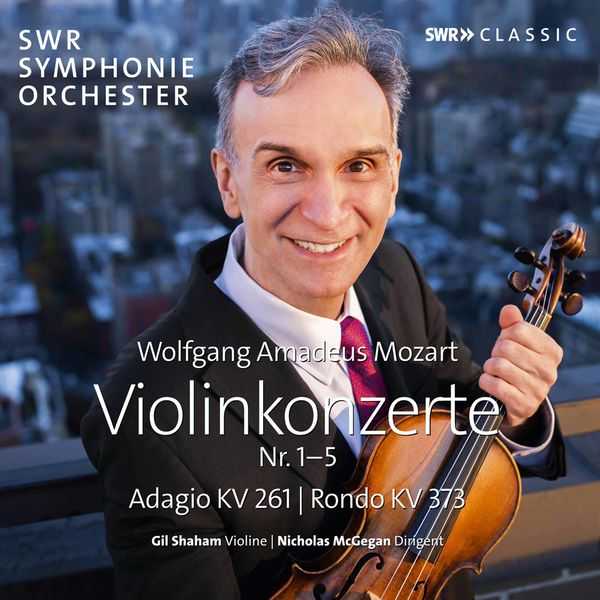

Composer: Wolfgang Amadeus Mozart
Performer: Gil Shaham
Orchestra: SWR Symphonieorchester
Conductor: Nicholas McGegan
Number of Discs: 2
Format: FLAC (tracks)
Label: SWR Music
Catalogue: SWR19113CD
Release: 2022
Size: 1.25 GB
Recovery: +3%
Scan: yes
CD 01
Violin Concerto No. 1 in B-Flat Major, K. 207
01. I. Allegro moderato
02. II. Adagio
03. III. Presto
Violin Concerto No. 3 in G Major, K. 216 “Strassburg”
04. I. Allegro
05. II. Adagio
06. III. Rondeau. Allegro
Violin Concerto No. 4 in D major, K. 218
07. I. Allegro
08. II. Andante cantabile
09. III. Rondeau. Andante grazioso
CD 02
Violin Concerto No. 2 in D major, K. 211
01. I. Allegro moderato
02. II. Andante
03. III. Rondeau. Allegro
04. Adagio in E Major for Violin & Orchestra, K. 261
Violin Concerto No. 5 in A Major, K. 219 “Turkish”
05. I. Allegro aperto
06. II. Adagio
07. III. Rondeau. Tempo di menuetto
08. Rondo in C Major for Violin & Orchestra, K. 373
Although Mozart’s five violin concertos represent only a very small part of his output (when compared to the 27 piano concertos and the 41 symphonies), they nevertheless belong to the core repertoire of all violinists. As with his piano concertos, Mozart’s violin concertos were all written in his younger years and are built on a constant dialogue between the solo instrument and the orchestra. Even in the first concerto, the violin is integrated into the orchestral texture, which in itself is much more than a mere accompaniment. Gil Shaham, one of today’s foremost violinists, creates gems of performances with these works. He is accompanied by the SWR Symphony Orchestra under Nicholas McGegan, who is renowned for his expertise in historically informed performance style.
Mozart may have only produced five violin concertos to his 27 piano concertos and 41 symphonies, but not a single one of these early-career works written in his late teens feels anything less than perfectly wrought, or betraying for the merest second his utter frustration at being pinned down as concertmaster in Archbishop Colloredo’s Salzburg court orchestra – his “day job” from 1769 aged 13 through to 1777, but a position he viewed as a dead-end one in comparison to the taster he’d already had of taking Europe by storm as a touring piano virtuoso.
So while there are more interesting ways of programming these works than simply all together as a library-building set, they do undoubtedly still make for a great listen as such, and here they’re joined by two concertante works Mozart composed for his successor in that post, Antonio Brunetti: the Adagio for Violin and Orchestra in E major, K. 261, written in 1777 apparently to replace a slow movement Brunetti considered “too sophisticated” (possibly Concerto No. 5 K. 219, given the key fits), then the Rondo in C major K. 373, which appears to have premiered in 1781 and thus stands as his final completed contribution to the violin concerto medium.
These are eminently elegant and tasteful readings. Shaham’s tone is one of lithe silver filigree sweetness, and the cadenzas (presumably his own, although there’s no mention of that in the notes) are both highly idiomatic and ear-catching. The SWR under McGegan meanwhile are abounding in period-aware, feather-light grace. In fact the sheer delicacy of these readings is very much a chief selling point, one especially striking instance of which is in No. 3’s Adagio, for the sudden super-pronounced, dreamy pianissimo softness with which its closing measures are delivered. The dialogue between soloist and orchestra is also unfailingly close.
The billion-dollar question, though, is whether they still emerge as frontrunners in what is already a crowded market for Mozart violin concerto sets, and ultimately for this particular critic they don’t quite supplant the glowing exuberance and crisp elegance heard on Isabelle Faust’s period readings with Giovanni Antonini and Il Giardino Armonico. Still, dedicated fans of Shaham and McGegan need not hesitate.



